November 22,
2005
By Candice Soobramoney
Twin sisters Nilayum and Isayum Reddy turn sweet 16 today and say
they're proud, as today also marks the birth of their spiritual
guru Shri Sathya Sai Baba, 80 years ago.
The birthday gals, identical twins, of Seaglen Gardens, Sea View,
Durban, say they will make celebratory plans today but will spend
this evening at a service at the Sai Centre in Yellowwood Park.
"Every year my parents, sister and I go to the Sai Centre to
attend the service to celebrate the birth of Shri Sathya Sai Baba.
"A concert will be held thereafter and Isayum and I will be
performing a Tamil song in praise of Baba. Devotees also sing a
birthday song for us," said Nilayum.
The articulate duo, who are the only children of Lochini, 44, a
pharmacy assistant, and Balan, 46, a teacher, and who are in grade
10 at Kharwastan Secondary, were born at St Aidan's Hospital.
Isayum was born at 12.10am and Nilayum three minutes later.
The girls, who are very proud of their Indian heritage, perform
Tamil film songs at wedding ceremonies and parties.
They also play a host of musical instruments. "Our dad, who is a
singer, got us involved in music about four years ago. Isayum and
I play the mhiridhintum, a South Indian classical drum, and the
tabla. In addition I play the harmonium and Isayum the violin,"
said Nilaym.
Their music teacher is 82-year-old Arunachalam Harry, of Road 701,
Chatsworth.
They girls also used to do bharata natayam dancing but stopped
when they turned 13 because "we became self-conscious to dance on
stage in front of people," said Isayum.
The girls say they are proud to uphold their culture. "There are
many teens who are very westernised and who are losing their
roots. Our parents have taught us to never shy away from upholding
our culture, which we do to the best of our abilities," said
Nilayum.
source:
http://www.thepost.co.za
Miracles of welfare - The week
 Sai Baba is winning hearts more with his
down-to-earth developmental work than with his supernatural feats Sai Baba is winning hearts more with his
down-to-earth developmental work than with his supernatural feats
By N. Bhanutej/Puttaparthi
In the 1940s, a young boy in the arid Anantapur district in
Andhra Pradesh talked of aeroplanes landing in his little village.
Heads of State would seek his feet, he said. The drought-weary
villagers laughed: "There is no bus to this village. What planes
is he talking about?"
Devotees who received vibhuti from Sai Baba or made
eye-contact with him say the experience changed them for ever.
The boy was unlike anybody his age. He rambled into verse,
prompting his family to believe he had demonic powers. He sat
villagers around him and launched into monologues. He produced ash
out of thin air. But planes? That was a far cry.
More than half a century later, his village, Puttaparthi, can
land a Boeing-747. Presidents, Prime Ministers, Governors, chief
ministers, judges, scientists, academicians and cricket and movie
stars touch his feet. Foreigners thirsting for Indian spirituality
make a beeline for a glance of the man who, they believe, is an
avatar of God. Sathyanarayana Raju, the village preacher, became
Sathya Sai Baba.
Sathyanarayana was born on November 23, 1926, to Pedda Venkama
Raju and Eshwaramma, who belonged to the Bhatta Raju caste. In
recent times, his devotees claim that he was born of immaculate
conception.
The boy had an inclination for the spiritual. He dropped out of
school in the eighth standard. At 13, he declared that he was the
reincarnation of Sai Baba of Shirdi, a revered sage in
Maharashtra, who died in 1918. He announced that he had a mission
in life; he did not belong to family.
Known as Sai Baba, Baba or Swami, he charmed people with his
talk. He performed 'miracles' to support his claims of divinity.
With a wave of his hand, he could produce vibhuti (sacred ash) and
other presents for his admirers: acts that earned him as many
critics as devotees.
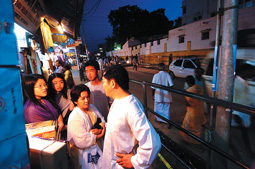 All roads lead to Puttaparthi: Devotees from
Indonesia All roads lead to Puttaparthi: Devotees from
Indonesia
A story told by his followers in Puttaparthi goes like this: as
a child, Baba would pluck any fruit that his friends wanted from a
tamarind tree on a hill near the Chitravathi river. Today, the
hill is a pilgrim spot. Visitors write their wish on a piece of
paper and string it to a branch of the tree, now called the
Kalpavruksha. They believe Baba would make those wishes come true.
Besides the miracles—he is said to have brought two dead people
back to life—Baba preached love, peace, selflessness, service and
other universal truisms like "Help Ever, Hurt Never" and "Love
All, Serve All".
News of an orange-robed god with a Jimi Hendrix hair-do spread
to the west. Westerners—disillusioned by an overdose of dollars,
relationships and drugs—sought Prashanthi Nilayam (Baba's ashram
in Puttaparthi) to rediscover the basics. One of Sai Baba's early
followers, Dr John S. Hislop, wrote in his book My Baba and I (Sri
Sathya Sai Books and Publications Trust): "I prayed that through
his grace and kindness, he might touch my dry heart and make it
alive and vibrant again." Hislop, a teacher in Mexico, became one
of the closest inner-circle devotees of Sai Baba. Devotees claim
that Baba's mere presence changes one's personality. Those who
received vibhuti or made eye-contact with him say that they
changed for ever.
Hislop narrates in his book that, in 1973, Baba 'materialised'
a figure of Christ on a wooden cross. Giving it to Hislop, Baba
claimed that the wood was from the cross on which Jesus was
crucified. When another devotee asked Baba about the crucifix, he
said: "Yes, I made it for him [Hislop]. And when I went to look
for the wood, every particle of the cross had disintegrated and
had returned to the elements. I reached out to the elements and
reconstituted sufficient material for a small cross. Very seldom
does Swami interfere with nature, but occasionally, for a devotee,
it will be done." It is said that Baba produced such a crucifix
for Sarah Ferguson, the Duchess of York, as well.
With Baba's meteoric rise in the 1970s, rationalists called him
a trickster and challenged him to produce larger presents. Late Dr
H. Narasimhaiah, former vice-chancellor of Bangalore University,
opened a debate by asking Baba to produce a melon instead of a
ring. He constituted a fact-finding committee to investigate Baba,
and sought an interview with him. The late Dr Abraham Kovoor, who
was president of the International Rationalists Association, was
invited to Bangalore, where he produced ash with the wave of his
hand.
"We went to schools and colleges and demonstrated all the
miracles that Sai Baba performed," recalled Dr A. Ramalingam,
retired head of botany department, Dharwad University, who was
member of the association. "Devotees claimed that ash was dropping
from Sai Baba's photographs. We showed that when mercuric chloride
is applied on the aluminium frame of any portrait, ash-like
residue starts falling from it."
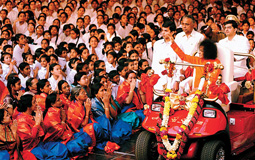 From a handful in the 1960s, Sai Baba's following
today is anywhere between one crore and five crore. From a handful in the 1960s, Sai Baba's following
today is anywhere between one crore and five crore.
Sai Baba did not answer his critics. Narasimhaiah did not get
an interview. But in a discourse, Baba said: "It is beyond you to
know how or why I create things. The objects that I create, I
create them by my will, the same way I created the universe."
Even now, devotees elbow each other during the darshans, hoping
to touch his feet or get invited to a private session where Sai
Baba usually 'materialises' gifts.
In 1978, the revolutionary balladeer Gaddar penned and
popularised a song ridiculing Sai Baba. He told THE WEEK: "In
India, you can exploit people in two ways. One, if you have the
capital to invest. Two, you invest in the ignorance of the people
and exploit them through superstition." Though Gaddar's song
became popular, the queues outside Prashanthi Nilayam and
Brindavan, his ashram in Whitefield, Bangalore, kept growing
longer.
On November 23, 1992, the Deccan Chronicle carried a photograph
from a TV footage of Baba taking a gold chain from his private
staff before 'materialising' it. On June 6, 1993, six inmates—of
the inner circle—of Prashanthi Nilayam died in Sai Baba's bedroom.
Two of them had allegedly made an attempt on Baba's life. The
other four were gunned down by the police, apparently in
self-defence. The facts of the case were never brought to light.
The most serious of charges—of sexual abuse—came from several
of his western young male devotees. A book by Tal Brooks titled
Avatar of Night describes the author's quest for God, his seeking
Sai Baba and his disillusionment when he was sexually exploited.
With the advent of the Internet, disillusioned young men narrated
more stories of abuse. Interestingly, there are devotees who
justify the alleged sexual acts as Baba's way of 'correcting' the
kundalini of the devotee.
The Unesco, not willing to accept this explanation, withdrew
from a conference on education in September 2000, which it was
co-sponsoring with the Sathya Sai Organisation in Puttaparthi. The
grounds: "Deeply concerned about widely reported allegations of
sexual abuse involving youth and children."
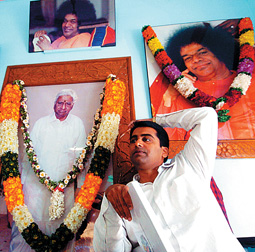 'Baba was, is and shall be': Ratnakar 'Baba was, is and shall be': Ratnakar
However, from a handful of
admirers in the 1960s, Sai Baba's following is today anywhere
between one crore and five crore. Puttaparthi, where Baba spends
nine months in a year (the other three months he is at
Whitefield), can house 10,000 devotees at a time. The organisation
has centres in over 160 countries. Said R.J. Ratnakar, Sai Baba's
nephew and member of the Sathya Sai Central Trust: "This is the
biggest NGO in the world after the United Nations. There may be
bigger organisations in terms of money, but we are the biggest in
terms of reach."
Nobody can put a finger on how much Sai Baba's organisation is
worth today. However, the scale of its drinking water projects,
hospitals and educational institutions gives an idea. The Sathya
Sai Central Trust, which puts Baba's thoughts into action, has
spent nearly Rs 1,000 crore on drinking water projects and
hospitals.
Started in 1995, the Sathya Sai Water Supply project provides
drinking water to 1.4 lakh people in 900 villages in Anantapur.
The organisation even modernised the 70km canal that connected the
Krishna waters from Kandaleru reservoir in Andhra Pradesh to
Chennai.
The Rs 250 crore super speciality hospital in Puttaparthi was
established in 1991. Ten years later, another hospital for
cardiology and neurology was set up in Bangalore at Rs 200 crore.
Ratnakar claims that the hospitals have conducted 75,000 surgeries
so far.
Sceptics were silenced when Sai Baba built water pipelines,
hospitals and educational institutions. "I don't care even if he
is a fraud. He is better than any politician in this country,"
said Leelavathi of Bangalore, whose husband underwent an open
heart surgery at the Sathya Sai Institute of Higher Medical
Sciences, Bangalore. "Who can provide such treatment in a
hospital? They perform free surgery and don't charge for the
patient's food. Just for this, I am willing to accept that he [Sai
Baba] is God."
Sai Baba's transition—from a miracle man to building welfare
projects such as water supply, health care and education—has
earned him a new set of non-believing supporters. Seen in the
context of a diminishing welfare state, his projects are a godsend
to the masses. Gaddar, however, attributes the transformation to
the mounting criticism. "Sai Baba had to change his line," said
Gaddar. "He produced water through pipelines, not through magic.
He had to build hospitals to cure ailments instead of relying on
his divine touch."
The 'new line' was evident in the responses of Sai Baba's
new-generation devotees as well. Said an inner-circle devotee,
when asked if he had ever seen Sai Baba perform a miracle:
"Millions of people coming here find love and peace. Don't you see
the miracle in that?"
|
A day in the life of Baba
By Lalita Iyer
Some say Baba never sleeps, or only for short periods. He
has 'raagi kanji' (porridge) and gets ready for the 7 a.m.
darshan. This is when he picks the people for a personal
darshan. He also has briefings between 7 a.m. and 8.30 a.m.
Lunch is between 10 and 10.30 a.m. The meal is prepared by
the wife of the late Janakiramaiah, Baba’s youngest brother.
Baba is the fourth of three brothers and two sisters and the
only surviving one. "When food arrives, it is handed over to
the attendants and they serve it to Baba," says Ratnakar,
Janakiramaiah’s son, who has the privilege of being the
closest nephew of Baba.
Issues are discussed with
Baba over lunch. He then retires to his room to read and rest.
At 1 p.m. he has fruit and confers with a different set of
functionaries. Before long, it is time for his 3.30 p.m.
darshan. Even as the car drives down the ramps, Baba listens
to the chants of the Vedas.
Baba gives personal interviews during the evening session
too and then stays back for the bhajans at 5.30 p.m. An hour
later he has a light dinner of one puri or some rice and
curry, and fruit.
At 7 p.m. he retires to his room to read letters. Baba does
not reply to any of them, but he says: "When you send a letter
to me, it is only a photocopy. The original is already with me
in my heart, when you thought of me and asked me something."
|
Puttaparthi
All's well with this world
By N. Bhanutej
Traversing rocky mountains and never-ending plains to reach
Puttaparthi, one does not expect gigantic film set-like buildings
in this back of beyond. Bordering on the gaudy, the buildings—the
hospital, the music academy, the university, etc.—painted mostly
in pink, have a stamp of Sathya Sai institutions on them. Even the
police station and the bus stand have temple architecture.
Puttaparthi's economy is booming. Crises like drought or stock
melt-downs don't seem to affect this over-grown village.
Puttaparthi comes to a halt only when Baba moves to his ashram in
Bangalore.
Every business establishment here displays a picture of Baba
prominently. Every establishment has 'Sai' in its name. Even to
get a waiter's attention in a restaurant, one has to shout 'Sai
Ram'. Beggars on the street call out 'Sai Ram' to passers-by.
On the main streets, there is a significant number of
foreigners. The economy revolves around these dollar-rich
visitors. There are also several Kashmiris, who sell carpets and
other handicrafts to foreigners.
Some shops exclusively sell pictures of Sai Baba. Said one
shopkeeper: "Ash could start falling from one of these pictures if
you are lucky."
Puttaparthi is completely vegetarian. Though not official,
there is a ban on liquor. Young boys in white are a common sight
here. They are students of one of the many colleges run by the
Sathya Sai Central Trust. When asked what he wanted to become, a
boy, who is doing B.Com., said: "I want to do MBA from our
institution. Swami will guide me on what to become."
Would he join a new-age company as an executive? "I am blessed
if Swami asks me to manage one of his institutions," he replied.
Students of institutions managed by the trust are forbidden from
speaking to the media, he said.
|
Guest Column
The guiding spirit
By N. Chandrababu Naidu
Adi Sankara, Vidyaranya, Ramanuja, Ramakrishna Paramahamsa,
Vivekananda, Aurobindo, the Buddha, Jesus Christ and Prophet
Mohammed are some of the holy manifestations who shaped the
cultural and spiritual destiny of India and the rest of the
world. Our generation is blessed to live in the presence of
Sathya Sai Baba. He did not propound a new faith, but
propounded a faith which underlines all faiths. He is a man of
infinite faith and infinite compassion.
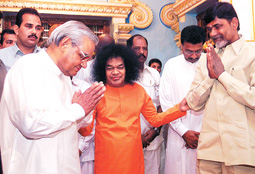 'Spiritually rewarding': Naidu
(right) and A.B. Vajpayee with Baba 'Spiritually rewarding': Naidu
(right) and A.B. Vajpayee with Baba
One cannot understand the significance of the life of a
mahatma from outside. His thoughts, feelings and deeds do not
belong to him—they embrace the universe. So, the life of Baba
transforms the world from within, so that it may move to
perfection. It is a life of service, purity and wisdom, which
sanctifies mankind and confers on it blessings that last.
Today, devotees all over the world sing bhajans that Baba
used to sing even as a young boy. He performed miracles and
the world took many years to understand this phenomenon of
Bhagvan. As years passed he constructed Prasanthi Nilayam
(abode of tranquillity) in Puttaparthi. It became a centre of
pilgrimage for his devotees the world over.
Bhagvan often says that there is only one religion, the
religion of love, and that there is only one language, the
language of the heart. To him service to human beings is
worship of God.
Bhagvan has provided drinking water to a number of villages
in just 12 months. Members of the Sri Sathya Sai Sevadals
provide medical aid to the suffering and engage in other
service-oriented activities.
Whenever I have had the privilege of a holy audience, Baba
showered his blessings on me, infused confidence in me,
inquired about the progress and development of the state,
offered his advice on many issues and listened with deep
interest and concern. Meeting him was always a mentally
elevating and spiritually rewarding experience.
Let us remember Bhagvan's philosophy of oneness of all
faiths, purity, patience, perseverance and selfless service,
sacrifice, self-realisation and, above all, love. Let us be
guided by his sublime ideas.
The writer is Telugu Desam
Party leader and former chief minister of Andhra Pradesh.
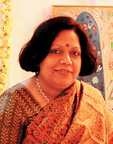 Always
there for the devotee Always
there for the devotee
By Scharada Bail
To those who face life with rationality and scepticism, Sai
Baba is only one in a pantheon of godmen. And then a crisis
sets this sceptic on a Sathya Sai journey. "I was facing
difficult times with the grandchildren," says Dr Premalatha
(name changed). "I would arrive tired from work, then beat
them at the slightest pretext, usually incited by some
complaint from my sister-in-law earlier in the day." Beating
them made her feel miserable. One such night, Baba appeared in
her dream. "Who is she to you?" Baba is said to have asked
her. "Baba showed me how wrong it was to make the children the
target of my frustration, and who was actually contributing to
this feeling of helplessness," she says.
Baba has been under attack, too. The BBC did it in The
Secret Swami, a film telecast last year that showed a video
clipping of Baba regurgitating a lingam. What was more
difficult for any viewer was the story of a boy who had been
sexually abused at the ashram. To the devotees, however, this
murky side of Baba is to be taken in one's spiritual stride.
"Seeing Baba is an experience difficult to describe," says
Nirupama, 19, whose grandparents, both doctors, have lived and
worked in Puttaparthi for many years. Says Nithya Raman, 20:
"He is there for me at all times. What you receive depends on
how strong your faith is." Members of a rock band, Nithya and
Nirupama don't hide their belief in Baba.
Rationalists have called him trickster and closet gay, but
none of the labels has stuck. What stays in memory are his
words that express the indefinable in a language all can
understand.
Scharada Bail is writer,
Internet consultant and Tarot practitioner based in Chennai. |
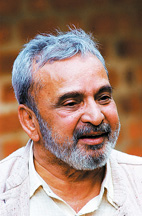 Counterpoint Counterpoint
Baba's magnetism is not spiritual
By U.R. Ananthamurthy
Although I grew up in an orthodox family, I questioned many of
our traditional notions, particularly the caste system. Hence, I
had difficulty in following a religious leader. I remember my
parents paying respects to Sai Baba when they were unhappy. Since
I loved them, I never criticised such things vehemently.
But it was funny to see people getting rings and vibhuti from
Sai Baba. It is cheap to make people believe in God through
tricks. To believe in a phenomenon like Sai Baba is like losing my
spiritual awareness. My friend's wife refused to undergo surgery
for breast cancer on Baba's assurance that she would be cured. She
died without an operation. It is wrong to advocate such belief
systems because all of us will die. We must realise this truth.
Once at the Hyderabad airport, Kannada writer Prof. V.K. Gokak,
who worked with Sai Baba, was waiting for him on the flight I was
on. Another well-known Kannada writer, V. Seetharamaiah, a
traditional man with petha [turban], was sitting next to me. "What
is happening?" I asked him. "The flight is delayed as they are
waiting for Sai Baba," he said.
Once Baba arrived, the crew and passengers, mostly
vice-chancellors of prominent universities, bowed to Sai Baba and
got vibhuti from him. "Why don't you go, sir?" I asked
Seetharamaiah. "I'm an old-timer," he replied. Real old-timers
didn't need a Sai Baba.
I cannot understand how people are not sceptical about Sai
Baba. One of the great Indian traditions is scepticism. Without
this, Buddhism, Jainism and Veerashaivism would not have been
born. India's true spirituality can be found in people like Kabir,
Basava, Tukaram, Ramakrishna Paramahamsa and Ramana Maharishi. I
don't know how to fit Sai Baba in that list. Between Sri Sri
Ravishankar [Art of Living Foundation] and Sai Baba, Sai Baba is
better because he is more easily available to the ordinary people.
I recently watched Sai Baba on television and he looked old and
sick. But there is kindness in his eyes. Many people are overcome
with emotion when they meet Sai Baba. But that magnetism is not
spiritual. People go to him for solace. Spiritualism is not solace
but to seek truth, which is harder. Spiritualism requires a kind
of mind like Jiddu Krishnamurti. I could argue with him. With Sai
Baba, either you believe him or you don't.
The 20th century is remarkable for three phenomena—hunger for
social justice, hunger for spirituality and hunger for modernity.
All the three went together. Mahatma Gandhi fought for social
justice and tried to get out of the caste system. The spiritual
streak in Gandhi emerged when he said 'Hey Ram' after he was shot
at. Today, hunger for spiritualism has given rise to commercial
gurus. Hunger of equality has degenerated into Lalu Prasad Yadav.
Modernity has become globalisation.
This is going to increase because of increasing rootlesness and
a loss of a sense of community. I have no problem with a religious
festival or even people taking the Ayyappa pilgrimage. Among
Ayyappa devotees, there is a sense of community and equality. The
problem is the hunger for persons like Baba.
What puzzles me is that he claims to be God and I laugh at him.
People also laughed at Lord Krishna when he claimed he was God. I
used to wonder if Sai Baba is also God, and if we are refusing to
acknowledge it.
I like certain things about Sai Baba. When BJP leader L.K.
Advani went on a ratha yatra, Sai Baba is believed to have said,
why build Ram temple at Ayodhya when he is present everywhere. I
appreciate his drinking water and health care initiatives. One
more thing I like about him is that he is not an English-speaking
person.
The land that gave birth to great people like Gandhi and Ramana
deserves better.
As told to Rajesh Parishwad
The writer is a well-known
Kannada writer and Jnanpith award winner.
|
Who next?
Waiting for Prema Sai
By N. Bhanutej
Asking about Baba's health can ruffle feathers at
Prashanthi Nilayam. Especially if the question comes from a
journalist. The secretary of the Sai Baba Central Trust
refused an interview. A request for an interview with Baba was
dismissed without a second thought.
Information on his health comes 'off the record'. An
inner-circle devotee, who did not want to be named, said that
Baba was using a wheelchair ever since his thigh bone
fractured in a fall in 2003. Surgery had not succeeded because
of "rejection", he said. The devotee quickly added that as Sai
Baba rarely travelled, the injury had not affected his
routine. "In fact, all those who have been saying that the
swami's health is failing are taking sick leave. He is as
active as ever. He has not missed a single appointment," he
said.
Decades ago, Sai Baba said that he would "leave his present
body" in 2022; that he would be reborn as Prema Sai Baba, in
Mandya district in Karnataka. In July 1975, a boy, Sai
Krishna, of Pandavapura in Mandya claimed to be Baba's next
avatar. A fact-finding committee set up by the late H.
Narasimhaiah, who was vice-chancellor of Bangalore University,
proved that the 'holy ash' produced by Sai Krishna was hidden
in the boy's vest, and that the pulling of a string delivered
it to his palm.
The organisation dismisses questions on who would succeed
Sai Baba thus: "How can anyone succeed God? Baba is for ever."
Said a member of the trust: "What is happening in Shirdi?
Everything is continuing even after Shirdi Sai Baba. Here,
too, it will go on like that."
"Who can replace God? Baba was, is and shall be," said
Baba's nephew R.J. Ratnakar. Would a certain Prema Sai Baba of
Mandya inherit the empire? "That is not known to us," said
Ratnakar. "It is known only to him [Baba]. It will happen if
he has said so. How that will be revealed, only time will
tell." |
 Social initiatives Social initiatives
Miracle School, Sandwich Men
Their silent service is tempered
with love and respect
By Dr Hiramalini Seshadri
When Dr Eric Fanibunda, a Parsi devotee, asked Sai Baba what
the objective of the Sathya Sai service organisation was, he said,
"Nothing", and then added: "Do not talk of the service you have
done but reflect on what service has done to you; selfless,
egoless service helps you grow spiritually." Yet a lot of good
gets done through the medicare, education and social welfare
projects and the credit should probably go to Baba's mother
Eshwaramma, who asked him to do something for Puttaparthi which
had no hospital, school or even proper drinking water.
Lifeline: The drinking water project has won Sai Baba a lot
of admirers
What began as a four-bed hospital in Puttaparthi in 1956, Sai
Medicare, spans six continents today. Free clinics are held
regularly and sometimes private hospitals offer wards and theatre
services where Sai surgeons operate for free and volunteers chip
in with medicines and food.
Networking with governments is also on. In Kenya, Sai mosquito
nets help keep malaria at bay. This year, Sai medical camps came
up all over the world when natural disasters struck. India has
taken the lead in establishing Sai hospitals. Besides two general
hospitals, two world-class tertiary care hospitals in Puttaparthi
and Whitefield that offer free treatment have drawn global
acclaim.
Educare—education in human values—is the foundation of Sathya
Sai schools and colleges. The Sri Sathya Sai Deemed University, of
which Baba is Chancellor, began as a college for women in
Anantapur in 1968. Recently, the UGC's National Assessment and
Accreditation Council awarded the A++ rating to the Sri Sathya Sai
Institute of Higher Learning.
The Sai organisation achieved in five years what governments
could not in decades—supplying drinking water to Anantapur, arid
areas of Medak and Mehboobnagar in Andhra Pradesh, and Chennai.
Till Baba's birthday last year when the shutters of the
Kandaleru-Pondi canal were opened, Chennai received only about
half the expected flow of 12 TMC from the Krishna river drinking
water scheme.
Work on the Chennai project, which cost $60 million (Rs 2,745
million), began soon after Baba's announcement on January 19,
2002. The capacity of the Kandaleru reservoir was upped to 59 TMC
and the extensive renovation of the canal—now the Sathya Sai Ganga
Canal—was completed in one year.
A lot of the work was done by Larsen & Toubro. "Constructing a
super speciality hospital in six months; creating civil aviation
history by constructing an airport in three and a half months;
laying 2,500 km of pipeline, building reservoirs and pumping
stations in rural terrains, and yet finishing in time—I simply
can't believe that we did it," said A. Ramakrishna, director, L&T.
Ramakrishna asked Baba the secret of the success. "All projects
are the same," said Baba. "But where there is unity and purity,
divinity manifests and automatically everything falls into place."
Many smaller projects are on the world over; like caring for
leprosy and AIDS patients in Africa, running homes and schools for
dropouts (one in Zambia is dubbed the 'Miracle School' as its
students won all the national prizes for academic excellence and
character), collecting food from hotels for distribution in inner
city ghettos (in New York, Sai volunteers are called the Sandwich
Men), building a motorable road in the Himalayan terrain so that
villagers can take their produce to the Kalimpong markets... the
list is endless. All service is tempered with love and respect.
Philip M. Prasad, a former Naxalite, best explains the success
of Sai initiatives in his book An Obstacle Race to Swami: "A
government or international agency dumps free sewing machines,
cows, buffaloes and agricultural implements in a tribal colony.
Next week you can pick these up from the money lender or the local
alcohol shops. Without a sturdy moral character no amount of
economic help works. In contrast, understand the village service
propounded by Baba.... Building national character is our primary
need; and it needs to be built from the core point of spirituality
to the outer layers of socio-economic existence and not
vice-versa."
Prasad cited the example of Russia to show that poverty cannot
be eliminated without character building. "For a resurgent India
with sustainable growth, we need to first strengthen her spiritual
core," he said. "Baba is doing just that."
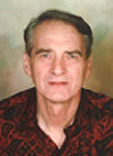 Awareness
of divinity Awareness
of divinity
Sathya Sai exudes a rare grace
that captivates seekers of truth
By Bill Aitken
Any attempt at summing up the contribution of God-men to
society—in modern India’s English media—is fraught with the
prospect of either audience fatigue or cynicism, especially when
the subject is Sri Sathya Sai Baba, an essentially vernacular
figure (his biodata is available only through translation from
Telugu). As a result, the views about Sai Baba’s place in the
history of religion veer from one extreme to another. While one
faction has a mass regard for him as the Godhead, the other
crusading minority clamours through the sensational press to have
his standing reduced to that of a common fraud.
Obviously it is only from the middle ground, examined by
objective, inquiring students of religion that Sai Baba’s status
can be expected to emerge. But such neutral observers are thin on
the ground. Having been a critic myself (of Sai Baba’s apparently
inflated spiritual claims), I have found on closer examination
over the years that my initial reaction was fairly normal and
actually welcomed by Baba.
I have been forced to revise my opinion and accept that this
person does not say he is divine to the exclusion of others. What
he says is that everyone of us has divinity within ourselves. He,
however, unlike the rest of us, is fully aware of this truth. It
is this sense of abiding awareness that many seekers (as opposed
to casual visitors) experience in his presence that sets this
teacher apart and makes him like no other spiritual phenomenon
that I have ever read about or personally checked out in the 50
years that I have studied comparative religion.
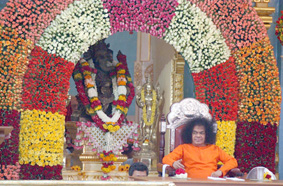 The theological contribution of the Sai saints has
been to emphasise the equality of souls before God. The theological contribution of the Sai saints has
been to emphasise the equality of souls before God.
The critical factor for determining his unusual spiritual aura,
oddly enough, is crystallised by the darshan of his slight but
remarkable physical presence. Sathya Sai exudes a rare grace that
captivates any seeker who is after the real things the human soul
hankers for. Between the hype of unhinged devotees and a howling
pack of detractors, his diminutive figure appears the same today
as it was when he was a boy—serenely established in a mood of
unaffected humaneness. When asked how his students should dress,
Baba replied with a subtle rebuke to today’s fashion of unconcern
for other’s problems: "Dress in such a manner that no poor person
in need of assistance will hesitate to ask you for help."
The category of divine is impossible to qualify but people rich
and poor, from all walks of life and different continents, confess
that in the presence of this unlikely fuzzy-haired Andhra peasant
they experience a grace that is like no other. Magically, it gives
rise to an awareness within the beholder that he or she too
possesses this priceless pearl of selfhood.
Sathya Sai is the occasion and trigger of this other-worldly
experience. His being is a reflection of the truth. This reality,
which he embodies momentarily, is awakened in the seeker. Unless
you savour this moment of grace, no amount of reasoning is going
to take you nearer to the meaning of life and understanding of the
pre-eminence of love. We are born to find this liberating truth in
ourselves. (Finding fault in others is not so urgent!)
This altogether mystifying personage, now celebrating his 80th
birthday, is strangely untouched by his outer state of rags to
spiritual riches story, and his inner state remains imponderable
to all, except, crucially, to himself. Inevitably, most
intellectuals who seek wisdom will shy away from the surrender of
their shining minds, especially before a backward villager. Custom
dictates that knowledge is power and the aim of life for most is
to seek the polar opposite of love. The few (of all nations and
conditions) who do foregather in Puttaparthi to celebrate the
paramountcy of love are at one with their teacher and themselves.
The observer gets the distinct feeling that the Bodhisattva or
avatar (or any exemplar of human compassion like Sathya Sai) is
the goal of human evolution. The greatest miracle on show at
Puttaparthi is to witness this humble villager’s natural graces
daily, which far exceed those of the so-called "most powerful man
in the world" in Washington.
The theological contribution of the Sai saints has been to
emphasise the equality of souls before God. This theistic approach
contradicts the paramountcy claimed by Sankaracharya for advaidic
monism. Historically, south India has led the north in shedding
the fatalistic notion that birth of the body decides the destiny
of the soul. Both Sai Baba of Shirdi and Sathya Sai Baba of
Puttaparthi have been revolutionary in preaching and practising
spiritual egalitarianism, which is particularly relevant to
India’s democratic policy still mired in a feudal mindset. It is
significant that both Sai Babas have emerged from the Deccan where
Dravidian influences mingle with the Brahminical, Islamic,
Christian, Sikh and Humanist. For the student of subcontinental
religious affairs it is fascinating to watch the cultural
arm-wrestling as Shirdi Sai, originally presented as an anonymous
Sufi in torn white kafni, is nowadays sought to be passed off as a
sanyasi in saffron with a Brahmin pedigree.
Having watched Baba for more than 30 years I have moved from my
original position of intellectual doubter to that of a fascinated
observer. I find he is a worthy understudy of Shirdi Sai and in my
own pantheon of great beings, he finds a place alongside the
Buddha and Christ.
Recently, Marianne Warren published her Ph.D thesis,
Unravelling the Enigma, arguing that since Shirdi Baba was a Sufi,
Sathya Sai’s claims to be an incarnation of him are totally
misplaced. This illustrates the limitations of the intellect and
how the presumptuousness of scholars blinds them to the obvious
fact that the mystery of rebirth is not open to proof one way or
the other. As in all religious affairs, these things are personal
matters and historicity is not as important to the heart as the
feeling of oneness the two Sai masters engender. When truly in
love the analytical mind is in abeyance.
The controversy over Sathya Sai’s status has thrown up elements
of the ridiculous at both extremes. His basic followers, Telugu
farmers in the early days of his mission, sought to see miracles
in everything the boy saint did. Chain letters were sent to stoke
the impression of a cult of unbalanced believers, totally at odds
with the teachings of Sai Baba—that you must weigh the evidence of
a teacher’s spiritual worth before taking the plunge of faith to
win his protective aura. When Professor Kasturi penned the
official life of Sathya Sai (as the perceived avatar of Lord Shiva
and Parvati), it was directed at a devotional, rustic audience.
For the rational reader, the most authentic biography of Sathya
Sai in English has been written by Howard Murphet, an Australian.
The exponential growth of the Sai mission after his sole
foreign trip to Uganda in 1968 saw a huge influx of overseas
interest and funds. The dramatic expansion of the Prasanthi
Nilayam ashram—with an international-class hospital, a deemed
university and massive outlay of drinking water schemes for the
drought-prone Rayalaseema district—helped the world to distinguish
the universal compassionate nature of Baba from his earlier image
of a miracle-mongering yogi. His unique, unchanging persona and
the dynamic harnessing of goodwill that he arouses for social
improvement make him much more than a conventional fund-raising
mahatma. He is one of the few compassionate beings rarely seen on
earth, concerned solely for the advancement of the human spirit.
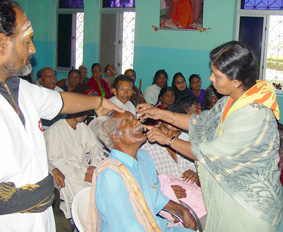 Sai Baba's concern for quality education and
medicare is a positive input for nation building. Sai Baba's concern for quality education and
medicare is a positive input for nation building.
At the other end of the spectrum
is the violently vociferous lobby of local rationalists (convinced
that Sai Baba is a confidence trickster) and international
apostate disciples (who paint Sai Baba as the Anti-Christ). To add
to the chagrin of these voluble detractors, who have criticised
his career in print and on the Internet with malicious intensity
for at least a generation, is the ongoing booming growth of his
mission. The more they rail against the saint, the greater, it
seems, is the number of people who flock to have his darshan.
The critics are so intemperate in
their dislike that their vituperation now comes across as almost
near comical in its predictability. Nothing Baba can say or do
meets their approval. If he provides drinking water to thirsty
villagers they scent a scam but if he doesn’t provide drinking
water he is anti-poor. The ground reality is that even Naxalites
have welcomed Baba’s charitable intervention, recognising in him a
fellow son of the Andhra soil. Often the impression given is that
the vilifiers do not hate Sai Baba as much as they harbour
contempt for the religious feelings of ordinary cultivators, whose
devotion has made Sathya Sai what he is.
Probably because of the intensity
of their hate, when it comes to a serious, forensic examination of
their allegations, they resort to bluster and evasion instead of
hard facts. Smearing sexual innuendo is a traditional ploy but on
failing to substantiate their charges, the critics switch to
another unrelated subject.
They will claim that all of Sathya Sai Baba’s materialisations
are phoney. However, this cannot stick either, because millions
have witnessed the outpouring of vibhuti at Shivaratri. So then,
financial irregularities are imputed to the saint, and when these
are likewise found to be unproductive of scandal, mafia happenings
are invoked. (As a longtime observer of ashrams, I always note how
Puttaparthi is exceptional in not making any monetary demands on
the visitor.)
The strategy of the critics seems to be that if sufficient mud
is thrown, some might stick. This hit and run behaviour suggests a
neurotic concern to damn by any possible means. Certain foreign
evangelical missions invest in these hate campaigns as a godly
task while in international forums, pressure on voting patterns is
discreetly applied by lobbyists of rival religions, to further
their own cause.
The latest in these so called exposes is a BBC documentary
whose agenda was so predetermined to denigrate Baba that it
stooped to the unethical use of a spy camera. In a last farcical
gesture, the producer hired some roadside entertainers to attempt
to simulate Baba’s chamatkar. The result is so ludicrous that it
leaves the viewer wondering as to who is funding this bizarre
display of hostile reporting. The BBC is ultimately governed by
the Anglican establishment, and churches in the west are losing
out financially to the appeal of the Sai Baba movement.
As a commercial broadcaster, the
BBC’s opting for sleaze would have the dual advantage of
discrediting a rival as well as getting good audience rating. The
Church of England can have no objection to programmes that weaken
perceived threats—like the papacy or Hindu holy men—to its
(declining) influence in the world. Posing as a lion in Asia, the
BBC is a mouse in Britain. It dare not criticise public icons like
the Queen, who happens to be the supremo of the Anglican church.
Even negative assessments of the
Sai movement have to concede that its growth has been phenomenal
and that, remarkably, there has been no missionary effort
involved. It has increased by spontaneous identification, where
individuals have been drawn to the persona and teachings of the
Sai saints, a voluntary outpouring of faith that has occurred in
an amazingly short period.
In appealing to the core of
spirit that lies beneath the surface of all religions, the Deccan
saints have not only made a dent in the fragmentary nature of the
subcontinental religious loyalties but also restored the classical
Upanishadic insight of the oneness of all faiths.
This augurs well with the Indian
democracy’s need to get beyond religious labels that have
stultified its development since Independence. Baba’s concern for
quality education and medical care is another positive input for
nation building. The success of his peninsula drinking water
network has proved that for efficient development, the crucial
ingredient is sincerity of purpose.
Bill Aitken is an expert on
comparative religion and a travel writer. He is author of Sri
Sathya Sai Baba: A Life.

source:
http://www.the-week.com/25nov27/currentevents_article10.htm
|



 Sai Baba is winning hearts more with his
down-to-earth developmental work than with his supernatural feats
Sai Baba is winning hearts more with his
down-to-earth developmental work than with his supernatural feats
 All roads lead to Puttaparthi: Devotees from
Indonesia
All roads lead to Puttaparthi: Devotees from
Indonesia  From a handful in the 1960s, Sai Baba's following
today is anywhere between one crore and five crore.
From a handful in the 1960s, Sai Baba's following
today is anywhere between one crore and five crore.  'Baba was, is and shall be': Ratnakar
'Baba was, is and shall be': Ratnakar  'Spiritually rewarding': Naidu
(right) and A.B. Vajpayee with Baba
'Spiritually rewarding': Naidu
(right) and A.B. Vajpayee with Baba 
 Counterpoint
Counterpoint Social initiatives
Social initiatives
 The theological contribution of the Sai saints has
been to emphasise the equality of souls before God.
The theological contribution of the Sai saints has
been to emphasise the equality of souls before God.  Sai Baba's concern for quality education and
medicare is a positive input for nation building.
Sai Baba's concern for quality education and
medicare is a positive input for nation building. 